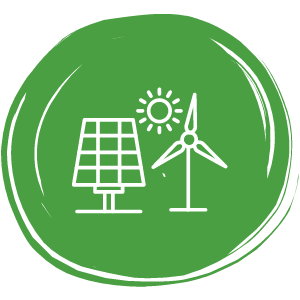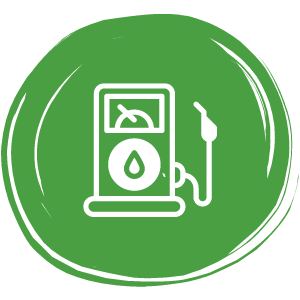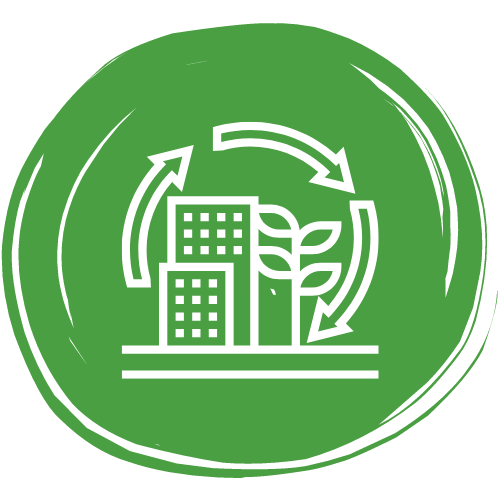In the supermarket, at the fuel pump and at the ballot box, Ireland is placing an ever-growing emphasis on environmental sustainability. But how green is Ireland really when you compare it to similar countries? This page uses real data to show exactly how Ireland is doing in its drive toward a more sustainable future.

CO2 emissions refer to the release of carbon dioxide into the atmosphere, primarily from burning fossil fuels. They significantly contribute to global warming and climate change, making them a key indicator of a country's environmental impact and eco-friendliness. According to the Intergovernmental Panel on Climate Change (IPCC), reducing CO2 emissions is essential for limiting global warming and achieving sustainable development goals.
This level of CO2 emissions puts Ireland 27th out of the 38 OECD countries. The Organisation for Economic Co-operation and Development (OECD) is a group of 38 similar economies, founded in 1961 to stimulate economic progress and world trade. Because all these countries have comparably mature economies and institutions, the OECD provides a useful benchmark when assessing Ireland's progress in the battle against climate change.
The Irish government plans to cut CO2 emissions by 75% in electricity, 50% in transport, and 56% in buildings by 2030, focusing on renewable energy expansion (e.g. solar), electric vehicles, and building retrofits.

CO2 is only one of the greenhouse gases — there are several others. For Ireland, the most significant one is Methane (CH4), not least because the global warming potential of CH4 is 21 times that of CO2. What's more, around 29% of Ireland's greenhouse gas emissions are methane from farming.
This level of emissions puts Ireland 35th out of the 38 OECD countries. According to the Irish Department of Agriculture, Food and the Marine, agriculture is the largest contributor to Ireland's overall emissions, accounting for 35% of the total emissions. Methane from livestock (particularly enteric fermentation) and nitrous oxide from fertilizers are the dominant GHGs in this sector.
By 2050, the Irish government aims to develop a climate-neutral food system, where the climate impact of biogenic methane is reduced to zero, and remaining agricultural emissions are balanced by removals through land use and contributions to renewable energy.

If Western governments are to meet their agreed 2050 climate targets, the shift to renewable energy sources will need to be swift and seismic. Here in Ireland, there is much work still to be done.
According to the Irish Government's 2024 Climate Action Plan, Ireland currently gets 38.6% of its electricity from renewable sources. Out of the 38 OECD countries, this puts Ireland 24th for its uptake of renewable energy.
By 2030, Ireland aims to increase its renewable electricity share to 80%, with 9GW of onshore wind, at least 5GW of offshore wind, and 8GW of solar PV capacity. The republic is also exploring the use of green hydrogen produced from surplus renewable electricity, which is expected to contribute to Ireland's energy system by the early 2030s.

Multiple studies have shown that over 97% of actively publishing climate scientists agree that human activities, particularly the burning of fossil fuels, are the primary drivers of recent global warming. Since 1850, approximately 2,500 billion metric tons of CO2 have been emitted into the earth's atmosphere, with fossil fuel combustion and industrial processes accounting for about 70% of these emissions.
If the world is to limit the effects of climate change, fossil fuels must be phased out as quickly and completely as possible.
Out of 38 OECD countries, the citizens of Ireland are the 14th most reliant on fossil fuels. Fuels such as coal, natural gas, oil, and peat still play a significant role in Ireland's energy landscape. For example, in the industry sector, fossil fuels accounted for 64% of final consumption in 2018.
However, Ireland is actively working to reduce this reliance. The Climate Action Plan sets a target to reduce the use of fossil fuels in the industry sector from 64% in 2018 to 45% by 2025. The plan includes measures such as expanding support for electrification, biomass adoption, and the use of low and zero-emission gases as alternative fuels.
The target for 2030 is to further reduce fossil fuel consumption in the industry sector to 30%. By the same date, The Irish government also aims to achieve 70-75% carbon-neutral heating. Additionally, all buildings will need to switch to heat pumps, efficient district heating, or other renewable sources by 2050, with new gas connections ending over time and a restriction on the installation of new fossil fuel heating systems in new or refurbished buildings.

If countries like Ireland are to meet their climate commitments, they must minimise and eventually nullify the amount of waste they produce. When materials like paper, plastic, glass, and metals are recycled, it lessens the need for raw material extraction, which is often energy-intensive and environmentally damaging. For instance, producing aluminium from recycled materials requires up to 95% less energy than creating it from raw bauxite ore (source ). By diverting waste from landfills, recycling also helps reduce methane emissions generated when waste is simply buried.
Out of 38 OECD countries, Ireland ranks 13th for its EPI Waste Recovery Rate. This metric refers to the proportion of waste material recovered through recycling, composting, or other processes out of the total waste generated. This rating is often used in environmental performance indices (EPIs) to assess how effectively a region, company, or system is at diverting waste from landfills and converting it into reusable resources.
Ireland's government is committed to meeting the EU's recycling targets, such as achieving a 60% recycling rate for municipal waste by 2030, and 65% by 2035 (source ). The plan also sets specific goals for reducing single-use plastics and increasing the recycling of packaging materials. For more information about Ireland's track record for recycling, check out our guide to circular living in Ireland.

The negative effects of greenhouse gases do not stop with climate change. Pollutants such as methane and nitrous oxide are also harmful to the human beings and animals who breathe them in. These pollutants are linked to respiratory diseases, and their reduction would not only address climate change but also improve the quality of life by reducing health risks associated with air pollution.
Compared to the other OECD countries, Ireland's air quality is good, ranking 8th in the list of 38 economies. As Ireland continues to implement its climate change strategy, its air quality will continue to improve, especially in urban and industrial areas.

Over time, government targets may require citizens to make sacrifices in their day-to-day lives. Insulating a home, getting solar panels, switching to an EV, perhaps eating less red meat and flying less often. For some, these measures won't always feel welcome. If citizens are to remain engaged as climate policies are rolled out, it is important that they 'buy in' to the necessity of such steps.
Currently, 87.2% of Ireland's population consider climate change to be a serious threat to humanity. That ranks them 9th out of 38 OECD countries.
In the study behind these statistics, participants were asked to score beliefs on a scale from 0 to 100 on four questions: whether action is necessary to avoid a global catastrophe; whether humans are causing climate change; whether climate change is a serious threat to humanity; and whether it is a global emergency.

As stated above, popular support is essential if policies aimed at tackling climate change are to be effective and sustainable in the long term. Ireland's is the 7th most supportive population in the OECD when it comes to climate action policy.
In the below study, support was measured on a scale from 0 to 100 across nine interventions, including carbon taxes on fossil fuels, expanding public transport, more renewable energy, more electric car chargers, taxes on airlines, investments in green jobs and businesses, laws to keep waterways clean, protecting forests, and increasing taxes on carbon-intensive foods.

This is a free resource commissioned and funded by PureVolt Solar Ireland. The Eco Hub has been developed by our green energy experts in collaboration with the engineers, scientists, and data specialists from our sister company SquareFish .
On pages like this one, we try to share our passion and motivations for a greener Ireland by presenting clear, factual information without getting on a soapbox. We hope this page is useful for you. Please get in touch to let us know if we can make it better :)